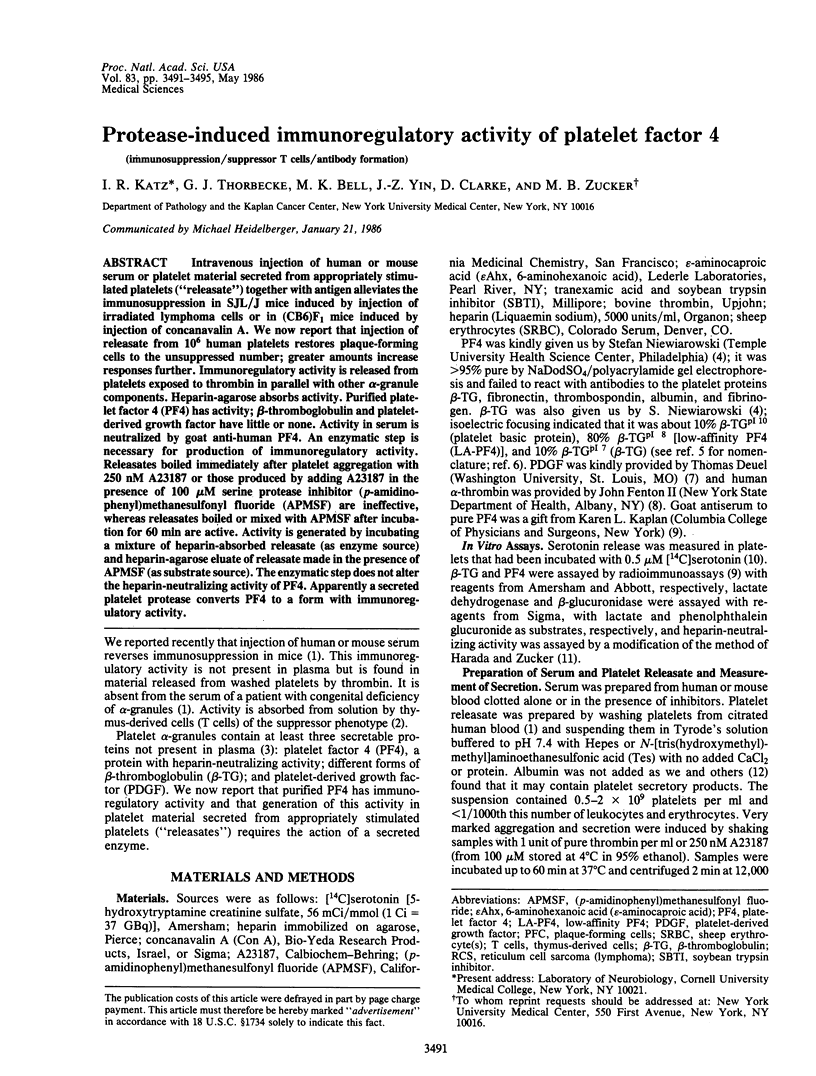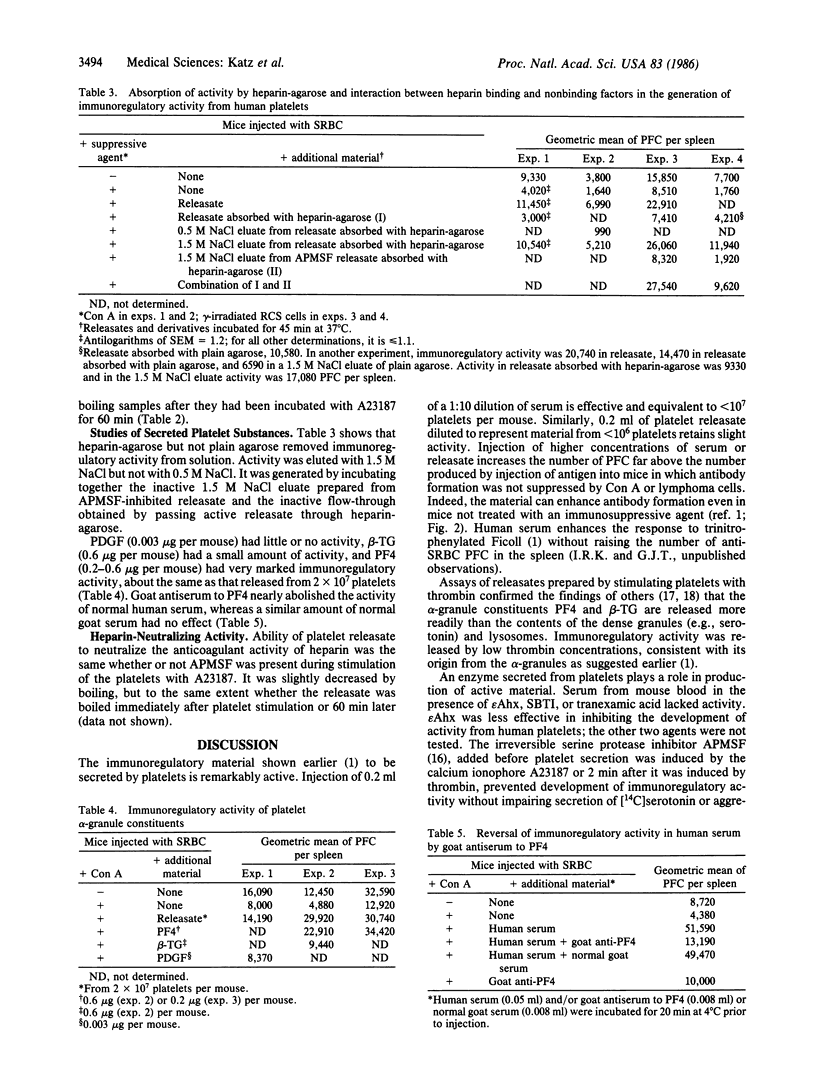Abstract
Intravenous injection of human or mouse serum or platelet material secreted from appropriately stimulated platelets ("releasate") together with antigen alleviates the immunosuppression in SJL/J mice induced by injection of irradiated lymphoma cells or in (CB6)F1 mice induced by injection of concanavalin A. We now report that injection of releasate from 10(6) human platelets restores plaque-forming cells to the unsuppressed number; greater amounts increase responses further. Immunoregulatory activity is released from platelets exposed to thrombin in parallel with other alpha-granule components. Heparin-agarose absorbs activity. Purified platelet factor 4 (PF4) has activity; beta-thromboglobulin and platelet-derived growth factor have little or none. Activity in serum is neutralized by goat anti-human PF4. An enzymatic step is necessary for production of immunoregulatory activity. Releasates boiled immediately after platelet aggregation with 250 nM A23187 or those produced by adding A23187 in the presence of 100 microM serine protease inhibitor (p-amidinophenyl)methanesulfonyl fluoride (APMSF) are ineffective, whereas releasates boiled or mixed with APMSF after incubation for 60 min are active. Activity is generated by incubating a mixture of heparin-absorbed releasate (as enzyme source) and heparin-agarose eluate of releasate made in the presence of APMSF (as substrate source). The enzymatic step does not alter the heparin-neutralizing activity of PF4. Apparently a secreted platelet protease converts PF4 to a form with immunoregulatory activity.
Full text
PDF




Selected References
These references are in PubMed. This may not be the complete list of references from this article.
- Deuel T. F., Huang J. S. Platelet-derived growth factor. Structure, function, and roles in normal and transformed cells. J Clin Invest. 1984 Sep;74(3):669–676. doi: 10.1172/JCI111482. [DOI] [PMC free article] [PubMed] [Google Scholar]
- Deuel T. F., Huang J. S., Proffitt R. T., Baenziger J. U., Chang D., Kennedy B. B. Human platelet-derived growth factor. Purification and resolution into two active protein fractions. J Biol Chem. 1981 Sep 10;256(17):8896–8899. [PubMed] [Google Scholar]
- Deuel T. F., Senior R. M., Chang D., Griffin G. L., Heinrikson R. L., Kaiser E. T. Platelet factor 4 is chemotactic for neutrophils and monocytes. Proc Natl Acad Sci U S A. 1981 Jul;78(7):4584–4587. doi: 10.1073/pnas.78.7.4584. [DOI] [PMC free article] [PubMed] [Google Scholar]
- Fenton J. W., 2nd, Fasco M. J., Stackrow A. B. Human thrombins. Production, evaluation, and properties of alpha-thrombin. J Biol Chem. 1977 Jun 10;252(11):3587–3598. [PubMed] [Google Scholar]
- Files J. C., Malpass T. W., Yee E. K., Ritchie J. L., Harker L. A. Studies of human plate alpha-granule release in vivo. Blood. 1981 Sep;58(3):607–618. [PubMed] [Google Scholar]
- Harada K., Zucker M. B. Simultaneous development of platelet factor 4 activity and release of 14C-serotonin. Thromb Diath Haemorrh. 1971;25(1):41–46. [PubMed] [Google Scholar]
- Hiti-Harper J., Wohl H., Harper E. Platelet factor 4: an inhibitor of collagenase. Science. 1978 Mar 3;199(4332):991–992. doi: 10.1126/science.203038. [DOI] [PubMed] [Google Scholar]
- Holt J. C., Niewiarowski S. Biochemistry of alpha granule proteins. Semin Hematol. 1985 Apr;22(2):151–163. [PubMed] [Google Scholar]
- JERNE N. K., NORDIN A. A. Plaque formation in agar by single antibody-producing cells. Science. 1963 Apr 26;140(3565):405–405. [PubMed] [Google Scholar]
- Jerushalmy Z., Zucker M. B. Some effects of fibrinogen degradation products (FDP) on blood platelets. Thromb Diath Haemorrh. 1966 May 15;15(3):413–419. [PubMed] [Google Scholar]
- Kaplan K. L., Broekman M. J., Chernoff A., Lesznik G. R., Drillings M. Platelet alpha-granule proteins: studies on release and subcellular localization. Blood. 1979 Apr;53(4):604–618. [PubMed] [Google Scholar]
- Kaplan K. L., Niewiarowski S. Nomenclature of secreted platelet proteins--report of the Working Party on Secreted Platelet Proteins of the Subcommittee on Platelets. Thromb Haemost. 1985 Apr 22;53(2):282–284. [PubMed] [Google Scholar]
- Kaplan K. L., Nossel H. L., Drillings M., Lesznik G. Radioimmunoassay of platelet factor 4 and beta-thromboglobulin: development and application to studies of platelet release in relation to fibrinopeptide A generation. Br J Haematol. 1978 May;39(1):129–146. doi: 10.1111/j.1365-2141.1978.tb07135.x. [DOI] [PubMed] [Google Scholar]
- Kaplan K. L., Owen J. Plasma levels of beta-thromboglobulin and platelet factor 4 as indices of platelet activation in vivo. Blood. 1981 Feb;57(2):199–202. [PubMed] [Google Scholar]
- Katz I. R., Hoffmann M. K., Zucker M. B., Bell M. K., Thorbecke G. J. A platelet-derived immunoregulatory serum factor with T cell affinity. J Immunol. 1985 May;134(5):3199–3203. [PubMed] [Google Scholar]
- Kenney D. M., Davis A. E., 3rd Association of alternative complement pathway components with human blood platelets: secretion and localization of factor D and beta 1H Globulin. Clin Immunol Immunopathol. 1981 Dec;21(3):351–363. doi: 10.1016/0090-1229(81)90224-5. [DOI] [PubMed] [Google Scholar]
- Kent J. P., Paton C. J., Kerry P. J. Platelet specific proteins in plasma protein fraction and human albumin. Thromb Haemost. 1984 Jul 29;51(3):406–406. [PubMed] [Google Scholar]
- Laura R., Robison D. J., Bing D. H. (p-Amidinophenyl)methanesulfonyl fluoride, an irreversible inhibitor of serine proteases. Biochemistry. 1980 Oct 14;19(21):4859–4864. doi: 10.1021/bi00562a024. [DOI] [PubMed] [Google Scholar]
- Legrand Y., Pignaud G., Caen J. P. Purification of platelet proteases: activation of proelastase by a trypsin-like enzyme. FEBS Lett. 1977 Apr 15;76(2):294–298. doi: 10.1016/0014-5793(77)80171-3. [DOI] [PubMed] [Google Scholar]
- Lonky S. A., Wohl H. Stimulation of human leukocyte elastase by platelet factor 4. Physiologic, morphologic, and biochemical effects on hamster lungs in vitro. J Clin Invest. 1981 Mar;67(3):817–826. doi: 10.1172/JCI110099. [DOI] [PMC free article] [PubMed] [Google Scholar]
- Luster A. D., Unkeless J. C., Ravetch J. V. Gamma-interferon transcriptionally regulates an early-response gene containing homology to platelet proteins. Nature. 1985 Jun 20;315(6021):672–676. doi: 10.1038/315672a0. [DOI] [PubMed] [Google Scholar]
- Mishell R. I., Dutton R. W. Immunization of dissociated spleen cell cultures from normal mice. J Exp Med. 1967 Sep 1;126(3):423–442. doi: 10.1084/jem.126.3.423. [DOI] [PMC free article] [PubMed] [Google Scholar]
- Niewiarowski S., Walz D. A., James P., Rucinski B., Kueppers F. Identification and separation of secreted platelet proteins by isoelectric focusing. Evidence that low-affinity platelet factor 4 is converted to beta-thromboglobulin by limited proteolysis. Blood. 1980 Mar;55(3):453–456. [PubMed] [Google Scholar]
- Rucinski B., Niewiarowski S., James P., Walz D. A., Budzynski A. Z. Antiheparin proteins secreted by human platelets. purification, characterization, and radioimmunoassay. Blood. 1979 Jan;53(1):47–62. [PubMed] [Google Scholar]
- Rucinski B., Poggi A., James P., Holt J. C., Niewiarowski S. Purification of two heparin-binding proteins from porcine platelets and their homology with human secreted platelet proteins. Blood. 1983 Jun;61(6):1072–1080. [PubMed] [Google Scholar]
- Senior R. M., Griffin G. L., Huang J. S., Walz D. A., Deuel T. F. Chemotactic activity of platelet alpha granule proteins for fibroblasts. J Cell Biol. 1983 Feb;96(2):382–385. doi: 10.1083/jcb.96.2.382. [DOI] [PMC free article] [PubMed] [Google Scholar]


